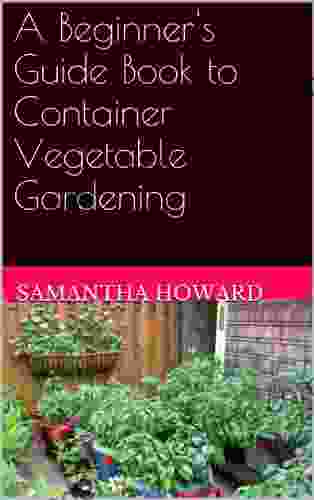Unlock the Secrets of Container Vegetable Gardening: A Beginner's Guide to Growing Your Own Fresh Produce

Are you longing to grow your own fresh, organic vegetables, but limited space is holding you back? Container vegetable gardening is the perfect solution for urban dwellers and apartment-dwellers alike, offering a convenient and accessible way to cultivate your own food. This comprehensive guide will provide you with all the essential knowledge and techniques you need to embark on your container gardening journey.
Benefits of Container Vegetable Gardening
- Maximizes space: Containers allow you to grow vegetables in even the smallest of spaces, making it ideal for balconies, patios, rooftops, and small yards.
- Improves soil health: By using fresh potting mix, you can avoid soil-borne diseases and ensure optimal growing conditions for your plants.
- Promotes early harvests: Containers warm up faster in the spring, allowing you to start your plants earlier and enjoy fresh produce sooner.
- Enhances mobility: Containers can be easily moved around to follow the sun or protect plants from inclement weather.
- Reduces water waste: Containers allow for more efficient watering, reducing water usage and preventing overwatering.
Choosing the Right Containers
The key to successful container vegetable gardening lies in selecting the right containers. Consider the following factors:
4.1 out of 5
| Language | : | English |
| File size | : | 1117 KB |
| Text-to-Speech | : | Enabled |
| Screen Reader | : | Supported |
| Enhanced typesetting | : | Enabled |
| X-Ray | : | Enabled |
| Print length | : | 14 pages |
| Lending | : | Enabled |
- Size: Choose containers that are large enough to accommodate the root systems of your vegetables. Larger containers are generally better, as they provide more room for growth and prevent roots from becoming pot-bound.
- Drainage: Ensure that your containers have adequate drainage holes to prevent waterlogging. Poor drainage can lead to root rot and other problems.
- Material: There are various container materials available, including plastic, terracotta, ceramic, metal, and wood. Choose a material that suits your budget, aesthetic preferences, and the specific needs of your plants.
- Color: Dark-colored containers absorb more heat, which can be beneficial for warmth-loving vegetables. Lighter-colored containers reflect more heat and are better suited for cooler climates or for plants that prefer moderate temperatures.
Preparing the Soil
The foundation of a successful container vegetable garden lies in the quality of the soil. Use a high-quality potting mix specifically designed for container gardening. It should be well-draining, rich in organic matter, and contain essential nutrients.
- Commercial potting mix: Look for potting mixes that are specifically formulated for vegetable gardening. They typically contain a blend of peat moss, compost, and other organic materials, providing a balanced and fertile growing medium.
- DIY potting mix: You can also create your own potting mix by combining equal parts peat moss, compost, and perlite. This mixture provides good drainage, aeration, and nutrient retention.
Selecting Vegetable Varieties
When choosing vegetable varieties for container gardening, consider the following factors:
- Space requirements: Opt for compact or dwarf varieties that are well-suited for limited spaces. Look for indeterminate varieties of tomatoes and cucumbers, which have a more compact growth habit.
- Growing season: Choose vegetables that are suitable for your local climate and growing season. Consider the amount of sunlight and the average temperatures in your area.
- Companion planting: Some vegetables grow well together and benefit from being planted in close proximity. For example, tomatoes and basil are known to be mutually beneficial companions.
Planting Your Vegetables
Plant your vegetables in the prepared potting mix, ensuring that they are spaced according to the recommended spacing for each variety. Water thoroughly after planting to settle the soil around the roots.
- Transplanting: If you are using seedlings, carefully transplant them into the containers, handling them gently to avoid damaging the roots.
- Seed starting: You can also start your own vegetables from seed in containers. Sow the seeds according to the instructions on the seed packet, and keep the soil moist until germination occurs.
Watering and Fertilizing
- Watering: Water your container vegetables regularly, especially during hot and dry weather. Allow the soil to dry out slightly between watering sessions, but avoid letting the plants wilt.
- Fertilizing: Fertilize your container vegetables every few weeks with a balanced liquid fertilizer. Follow the instructions on the fertilizer package for the recommended dosage and application frequency.
Pest and Disease Control
Container vegetable gardens are generally less prone to pests and diseases than in-ground gardens. However, it is still important to monitor your plants regularly for any signs of trouble.
- Pest control: Use organic methods to control pests, such as insecticidal soap or neem oil. Avoid using harsh chemical pesticides, as they can harm beneficial insects.
- Disease prevention: Water your plants at the base to avoid getting the leaves wet, as this can promote fungal diseases. Remove any diseased plants immediately to prevent the spread of infection.
Harvesting Your Vegetables
Harvesting your homegrown vegetables is the ultimate reward for your efforts. When your vegetables are ripe, carefully pick them from the plants.
- Harvesting tips: Use sharp shears or scissors to harvest vegetables. Avoid pulling or tearing the plants, as this can damage the root systems.
- Storage: Store your harvested vegetables in a cool, dark place to extend their shelf life. You can also preserve them by freezing, canning, or drying.
Container vegetable gardening empowers you to grow your own fresh, organic produce even in the most limited of spaces. By following the tips and techniques outlined in this guide, you can create a thriving vegetable garden that provides you with a continuous supply of delicious and nutritious food. Embrace the joy of container gardening and enjoy the fruits of your labor with every meal.
4.1 out of 5
| Language | : | English |
| File size | : | 1117 KB |
| Text-to-Speech | : | Enabled |
| Screen Reader | : | Supported |
| Enhanced typesetting | : | Enabled |
| X-Ray | : | Enabled |
| Print length | : | 14 pages |
| Lending | : | Enabled |
Do you want to contribute by writing guest posts on this blog?
Please contact us and send us a resume of previous articles that you have written.
 Book
Book Novel
Novel Page
Page Chapter
Chapter Text
Text Story
Story Genre
Genre Reader
Reader Library
Library Paperback
Paperback E-book
E-book Magazine
Magazine Newspaper
Newspaper Paragraph
Paragraph Sentence
Sentence Bookmark
Bookmark Shelf
Shelf Glossary
Glossary Bibliography
Bibliography Foreword
Foreword Preface
Preface Synopsis
Synopsis Annotation
Annotation Footnote
Footnote Manuscript
Manuscript Scroll
Scroll Codex
Codex Tome
Tome Bestseller
Bestseller Classics
Classics Library card
Library card Narrative
Narrative Biography
Biography Autobiography
Autobiography Memoir
Memoir Reference
Reference Encyclopedia
Encyclopedia Michel Odent
Michel Odent Zeynep Ton
Zeynep Ton Timothy Dickeson
Timothy Dickeson Susan B Anderson
Susan B Anderson Steve Hilker
Steve Hilker Sherry A Burton
Sherry A Burton Skylar Lewis
Skylar Lewis Kathryne Kennedy
Kathryne Kennedy Teresa Warren
Teresa Warren Laura Portwood Stacer
Laura Portwood Stacer Suleiman Omar
Suleiman Omar Timo Holmquist
Timo Holmquist Miss Aida
Miss Aida Kristie Robin Johnson
Kristie Robin Johnson Takeo Yoshikawa
Takeo Yoshikawa Tamara Bower
Tamara Bower Reymundo Sanchez
Reymundo Sanchez Lore Cottone
Lore Cottone Rosary O Neill
Rosary O Neill Lisa A Wroble
Lisa A Wroble
Light bulbAdvertise smarter! Our strategic ad space ensures maximum exposure. Reserve your spot today!

 Herb SimmonsThe Last Voyage of the Karluk: A Gripping Arctic Adventure That Chills to the...
Herb SimmonsThe Last Voyage of the Karluk: A Gripping Arctic Adventure That Chills to the... Dean ButlerFollow ·9.8k
Dean ButlerFollow ·9.8k Arthur Conan DoyleFollow ·15.1k
Arthur Conan DoyleFollow ·15.1k Joe SimmonsFollow ·14.2k
Joe SimmonsFollow ·14.2k Art MitchellFollow ·10k
Art MitchellFollow ·10k Cason CoxFollow ·16.4k
Cason CoxFollow ·16.4k Dustin RichardsonFollow ·15.5k
Dustin RichardsonFollow ·15.5k Darnell MitchellFollow ·2k
Darnell MitchellFollow ·2k James JoyceFollow ·8.1k
James JoyceFollow ·8.1k

 Liam Ward
Liam WardUnleash the Power of Goblin Slayer: Discover the Gripping...
Enter the Shadowy Realm of...

 Eli Brooks
Eli BrooksWalking the Territory: Your Essential Companion for...
Adventure Awaits! Prepare to immerse yourself...

 Floyd Richardson
Floyd RichardsonGoblin Slayer: A Gripping Light Novel Series That Will...
Step into the shadowy...

 Dennis Hayes
Dennis HayesFrom Strategy to ROI: The Ultimate Guide to Driving...
In the dynamic and competitive business...

 Edward Reed
Edward ReedUnveiling the Rich Tapestry of Tennis in Britain: A...
: Tennis - A British Love Affair Tennis, a...

 Michael Crichton
Michael CrichtonEscape into the Thrilling World of "Here and Now" by...
In the tapestry...
4.1 out of 5
| Language | : | English |
| File size | : | 1117 KB |
| Text-to-Speech | : | Enabled |
| Screen Reader | : | Supported |
| Enhanced typesetting | : | Enabled |
| X-Ray | : | Enabled |
| Print length | : | 14 pages |
| Lending | : | Enabled |









